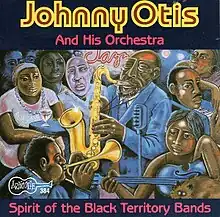| Spirit of the Black Territory Bands | ||||
|---|---|---|---|---|
 | ||||
| Studio album by | ||||
| Released | 1992 | |||
| Label | Arhoolie[1] | |||
| Producer | Johnny Otis, Tom Morgan | |||
| Johnny Otis chronology | ||||
| ||||
Spirit of the Black Territory Bands is an album by the American musician Johnny Otis, credited as Johnny Otis and His Orchestra.[2][3] It was released in 1992.[4] The album is a tribute to the music of the territory bands of Otis's youth; Otis played with several such bands in the 1940s.[5][6]
The album was nominated for a Grammy Award, in the "Best Large Jazz Ensemble Performance" category.[7][8]
Production
The album was produced by Otis and Tom Morgan.[9][10] Otis's son, Shuggie, played guitar and helped to arrange the songs. His other son, Nicky, played drums.[11] Otis employed a 10-piece horn section.[12] The album was largely made up of Count Basie and Duke Ellington songs.[13] The album cover is a painting by Otis.[14]
Critical reception
| Review scores | |
|---|---|
| Source | Rating |
| AllMusic | |
| The Encyclopedia of Popular Music | |
| MusicHound R&B: The Essential Album Guide | |
The San Francisco Chronicle wrote that "the arrangements lay curling, fine-point filigree behind blasting individual efforts with a prevailing robust spirit that simply smokes."[12]
AllMusic deemed the album "competent but hardly thrilling."[15] The Penguin Guide to Blues Recordings noted Otis's "continued engagement with jazz," and concluded that "it's unlikely that swing fans will be disappointed."[17]
Track listing
| No. | Title | Length |
|---|---|---|
| 1. | "Swinging the Blues" | |
| 2. | "Margie" | |
| 3. | "You're Drivin' Me Crazy/Moten Swing" | |
| 4. | "The Mooche" | |
| 5. | "Flying Home" | |
| 6. | "Harlem Nocturne" | |
| 7. | "Jumpin' at the Woodside" | |
| 8. | "Sophisticated Lady" | |
| 9. | "Jumpin' the Blues" | |
| 10. | "Creole Love Call" | |
| 11. | "Rock-a-Bye Basie" |
References
- ↑ Vacher, Peter (September 17, 2015). "Swingin' on Central Avenue: African American Jazz in Los Angeles". Rowman & Littlefield – via Google Books.
- ↑ Ouellette, Dan (Mar 1993). "Johnny Otis". DownBeat. 60 (3): 14.
- ↑ "Lowell Fulson & Johnny Otis To Headline Troyce Key Music Scholarship Fund Benefit". Oakland Post. Vol. 29, no. 106. 28 Apr 1993. p. 9.
- 1 2 Larkin, Colin (2006). The Encyclopedia of Popular Music. Vol. 6. MUZE. p. 353.
- ↑ Toombs, Mikel (March 20, 1991). "Otis' drive: Keep black music alive". The San Diego Union-Tribune. p. C1.
- ↑ Hale, Mike (October 16, 1994). "ROOTS OF RHYTHM & BLUES: JOHNNY OTIS PLANTS HIS FEET AND MAKES REAL AN OLD DREAM". Arts. San Jose Mercury News. p. 3.
- ↑ "Johnny Otis". Recording Academy. Retrieved 31 July 2022.
- ↑ Clark, Rick (Mar 26, 1994). "Know Your Neighbors". Billboard. 106 (13): 84.
- ↑ The Encyclopedia of Record Producers. Billboard Books. 1999. p. 600.
- ↑ Otis, Johnny (November 19, 1993). "Upside Your Head!: Rhythm and Blues on Central Avenue". Wesleyan University Press – via Google Books.
- ↑ Lipsitz, George (July 31, 2010). "Midnight at the Barrelhouse: The Johnny Otis Story". U of Minnesota Press – via Google Books.
- 1 2 Selvin, Joel. "JOHNNY OTIS AND HIS ORCHESTRA: Spirit of the Black Territory Bands". SUNDAY DATEBOOK. San Francisco Chronicle. p. 39.
- ↑ Jowers, Andrew (16 Nov 1994). "SHUGGIE OTIS BACK ON THE BLUES SCENE". The Press Democrat. p. P1.
- ↑ "Johnny Otis: Black by Persuasion". JazzTimes. Retrieved 31 July 2022.
- 1 2 "Johnny Otis - Spirit of the Black Territory Bands Album Reviews, Songs & More | AllMusic" – via www.allmusic.com.
- ↑ MusicHound R&B: The Essential Album Guide. Visible Ink Press. 1998. p. 438.
- ↑ The Penguin Guide to Blues Recordings. Penguin Books Ltd. 2006. p. 507.